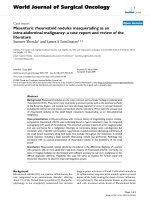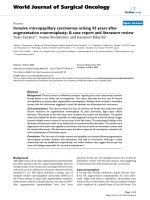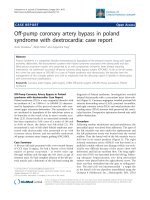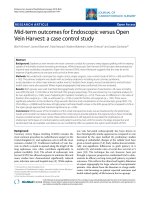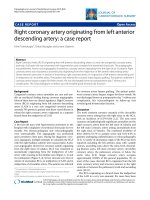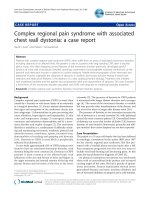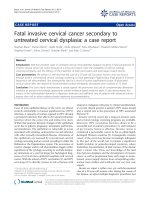Báo cáo y học: " Large infrapatellar ganglionic cyst of the knee fat pad: a case report and review of the literature" potx
Bạn đang xem bản rút gọn của tài liệu. Xem và tải ngay bản đầy đủ của tài liệu tại đây (3.71 MB, 7 trang )
CAS E REP O R T Open Access
Large infrapatellar ganglionic cyst of the knee fat
pad: a case report and review of the literature
Ioannis Nikolopoulos
1*
, George Krinas
2
, Dimitris Kipriadis
2
, Apostolos Ilias
2
, Andreas Giannakopoulos
2
and
Stephanos Kalos
2
Abstract
Introduction: Large ganglionic cystic formations arising from the infrapatellar fat pad are quite uncommon and
only a few are mentioned in the literature. An open excision in these cases is mandatory.
Case presentation: We report the case of a large infrapatellar fat pad ganglion in a 37-year-old Greek man with
chronic knee discomfort. The ganglionic cys t originated from the infrapatellar fat pad and had no intrasynovial
extension. The final diagnosis was determined with magnetic resonance imaging of the knee, and the lesion was
treated wi th surgery.
Conclusions: These lesions are asymptomatic in most cases but often are misdiagnosed as meniscal or
ligamentous lesions of the knee joint. Nowadays, the therapeutic trend for such lesions is arthroscopic excision, but
when there is a large ganglion, as in this case report, the treatment should be an open and thorough resection.
This report is intended mostly but not exclusively for clinical physicians and radiologists.
Introduction
Cystic lesions around the knee are common. Of these,
popliteal cysts are the most frequently encountered.
Other cystic lesions, including meniscal or ganglion
cysts, are less common [1,2]. A ganglion, by definition,
is a cystic swelling that is formed of myxoid matrix,
which gives the ganglion a jelly-like consistency, and is
lined with a pseudomembrane.
Gangliaaboutthekneearerareandusuallyare
located within the joint, in juxtaposition to the joint, or
in the soft tissues around the joint, within muscles, ten-
dons, or nerves. Intra-articular small ganglia are often
confused with meniscal cysts [3]. Many of these lesions
are i ncidental findings o n magnetic resonance imaging
(MRI) or arthroscopy, a re of little clinical significance,
and usually are asymptomatic.
Ganglion cysts do not have a fixed s et of common
symptoms and their symptoms may correlate with size
and the location within the knee joint [4]. Knee pain,
clicks, stiffness, incomplete extension of the knee, and
pain at the extremes of motion are common symptoms.
Occasional findings include a palpable mass and bone
erosion. Cysts anterior to the anterior cruciate ligament
(ACL) tend to limit extension, and those posterior to
the posterior cruciate ligament (PCL) to limit flexion.
The infrapatellar fat pad, known as Hoffa ’sfatpad,is
located posterior to the patellar ligament and adjoining
capsule separating them from the synovium. The differ-
ential diagnosis of swelling in the infrapatellar fat pad
region, as we will show, includes lipoma, synovial cyst,
meniscal cyst, and ganglion.
Case presentation
We report the case of a 37-year-old Greek man who
was seen in our outpatient clinic and who had anterior
left knee pain that lasted more than five months. A clin-
ical examination showed a 5 cm visible and palpable
mass at the level of the m edial patellar rim of his left
knee (Figure 1).
Our patient had no limitation of knee range of motion
apart from a minor l ack of flexion and no knee effusion,
and he had tenderness over the swelling upon local pal-
pation.TheresultsofLachman-Noulis,Apley,and
McMurray tests were negative, and X-rays showed no
bony abnormalities. Initially, our predominant diagnosis
was medial meniscal cyst.
* Correspondence:
1
General Hospital “Asclepeion Voulas”, 1, Macedonias Street, Anixi, Attica,
14569, Greece
Full list of author information is available at the end of the article
Nikolopoulos et al. Journal of Medical Case Reports 2011, 5:351
/>JOURNAL OF MEDICAL
CASE REPORTS
© 2011 Nikolopoulos et al; licensee BioMe d Ce ntral Ltd. This is an Open Access article distributed under the terms of the Creative
Commons Attribution License ( which permits unrestricted use, distribution, and
reproduction in any medium, provided the original work is properly cited.
An MRI examination was performed with T1-
weighted, proton density (PD) and T2-weighted
sequences with fat saturation in sagittal, axial, and coro-
nal planes. The MRI examination revealed a large well-
defined multilobular 5 cm cystic formation in the Hof-
fa’s fat pad with the p resence of intralesional septa. The
lesion showed lo w signal intensity on T1-weighted
images and high signal intensity on T2-weighted and
PD images (Figures 2, 3, 4). MRI also showed regular
morphology and signal intensity of menisci, ACL, PCL,
and the rest of the capsuloligamentous components, and
there were a few small chondral lesions on the patellar
articular surface. No intra-articular fluid was shown.
We decided to t ake our patient into surgery, but our
main concern was the kind of surgical modality that was
indicated for this case. Our dilemma was the choice
between arthroscopic or open excision of the ganglion.
After thoroughly researching the literature, we decided
on an open procedure.
When the surgical excision was performed, spinal
anesthesia and a tourniquet were used, and the mass
was approached via an incision over the cystic mass
medially to the patellar tendon (Figure 5A). A multilob-
ular mass of 5 cm was found inside the infrapatellar fat
pad with a firm attachment to the capsule (Figure 5B).
A very careful dissection of the whole mass along with a
portion of the capsule was performed, and a substantial
synovial defect was left (Figure 5C). The defect was
repaired, and the wound was closed in layers. Macrosco-
pically, there was a multi lobular cystic m ass with a rub-
bery wall and a clear jelly-like content (Figure 6A, B).
The septa inside the cyst, detected on MRI, were not
verified when the cyst was incised. A histological exami-
nation of the resected mass confirmed the diagnosis of
ganglionic cyst. On hematoxylin-and-eosin staining, a
fibrous-walled cyst associated with enclosed myxoid
areas and fatty cells adjacent to the fibrous capsule was
seen (Figure 7A-C).
The postoperative period was uneventful, and our
patient was able to return, with no complaints, to his
job and previous activities within three weeks. When he
was re-evaluated six months after the operation, his
knee range of motion was normal and there was no
palpable swelling. He had no complaints and no pain
from the knee joint on gait or during sports.
A new MRI of his lef t knee showed no evidence of a
residual cystic lesion in the remaining fat pad. Of
course, there was a mild increase in signal intensity on
T2-weighted sequences because of previous surgery. As
expected, the right knee MRI showed no joint pathology
at all (Figure 8A, B).
Discussion
Ganglion cysts within the knee cavity are rare and
usuallyoriginatefromthecruciateligaments,the
menisci, the alar folds that cover the patellar fat pad [5],
Figure 1 Swelling inferomedially to the patella of the left knee mimics a medial meniscal cyst.
Nikolopoulos et al. Journal of Medical Case Reports 2011, 5:351
/>Page 2 of 7
and the popliteus tendon and from osteochondral frac-
tures or subchondral bone cysts [6]. The reported preva-
lences of intra-articular ganglia in the knee are from
0.2% to 1% on knee MRI and 0.6% on knee arthroscopy
[7]. Many cases of ganglia, ranging in size from 1.8 to
4.5 cm, have been reported [8], and occasionally they
are bilateral. Most of them are incidental findings and
of little clinical significance.
The first intra-arti cular knee ganglion was described
by Caan [9] in 1924, and there have been several refer-
ences to ganglia around the knee since then. Brown and
Dandy [10] reported 38 intra-articular ganglia in 6500
knee arthroscopies and half of the pati ents had no other
abnormality.
The differential diagnosis of knee cystic lesions must
include ganglia, lipoma, synovial myxoma, meniscal or
parameniscal cyst, synovial cysts, pigmented villonodular
synovitis, synovial hemangioma, aneurysm, synovial sar-
coma, and synovial chondromatosis [4]. Symptomatic
ganglia usually present with a history of or signs of
mimicking an internal derangement of the knee. The
differential diagnosis should include meniscal injury,
loose body, chondral flaps, osteoarthritis, cyst of
menisci, or discoid meniscus [4,10].
Ganglion cysts do not have a fixed s et of common
symptoms, and their symptoms may correlate with size
and the location within the knee joint [4]. Knee pain,
clicks, stiffness, incomplete extension of the knee, and
pain at the extremes of motion are common symptoms.
Occasional findings include a palpable mass and bone
erosion.
Imaging studies include plain X-rays to exclude
pathologies such as a loose body or other bone abnorm-
alities. Ultrasound (U/S), computed tomography (CT)
scan, and a rthrography are not very helpful examina-
tions, and MRI is the most sensitive, specific, accurate,
and noninvasive method for depicting cystic masses,
including their size and location. In addition, MRI helps
to exclude neoplast ic lesions a nd to detec t other intra -
articular pathologi es [3]. The characteristic findings of a
ganglion cyst include a fluid-filled lesion with low T1-
weighted and high T2-weighted signal intensities in MRI
D C
B A
Figure 2 Sagittal magnetic resonance images of the knee. (A, B) Sequential T1-weighted images of a cystic lesion with low signal intensity
inferior to patella within the Hoffa’s fat pad. (C, D) Sequential T2-weighted images, at the same level, of a well-demarcated, multilobular cystic
mass with high signal intensity. Note the extrasynovial intra-articular location of the lesion.
Nikolopoulos et al. Journal of Medical Case Reports 2011, 5:351
/>Page 3 of 7
[3]. In histological sections, ganglia show a d ense con-
nective-tissue capsule with a thick jelly-like content.
Microscopy shows a pseudocystic space with small mul-
tifocal areas of mucoid degeneration.
A variety of treatment modalities have been employed
to treat intra-articular ganglion cysts of the knee. Spon-
taneous size reduction has been reported [8]. Exc ellent
results with percutaneous aspiration using U/S and CT
guidance have also been obtained [11]. Recently, the
trend i s for arthroscopic excision of intrarticular cysts
[12,13]. However, the recurrence of ganglia after arthro-
scopic treatment has been re ported with cyst reforma-
tion [14]. In such cases, the recurrence risk is high;
therefore, patients should be followed up more carefully
[15].
We believe that puncturing the lesion in an attempt to
reduce its content reduces its volume but does not alter
its margins. On the contrary, when the lesion collapses,
it is very difficult to pinpoint the margins of the pseudo-
capsule extension, especially when an arthroscopy is
performed for a lesion within the fat pad. Therefore, we
believe that puncturing the lesion poses a high potential
risk of recurrence. Of course, open excision of an infra-
patellar fat pad ganglionic cyst does not nullify the
recurrence risk, but given the literature data mentioned
above, arthroscopic treatment of such lesions has high
recurrence rates [14].
On the other hand, when an open procedure for a
large ganglionic cyst of the knee has been decided upon,
the preservation of an intact synovium should be the
main consideration of t he surgeon. Unfortunately, in
our patient, the preservation of an intact synovium was
inevitable because of the lesion’s firm attachment to the
capsule (Figure 5C). Our decision to carry on with an
open excision o f the ganglion lesion was b ased more on
our pursuit for a complete resection of the lesion in
orde r to diminish the recurrent rates and less on avoid-
ing synovium invasion. The substantial defect of the
synovium that was left after the complete resection of
the ganglion was repaired by approximating the defect
margins with interr upted sutures. The latt er would b e
quite difficult with an arthroscopic procedure that
C D
B A
Figure 3 Coronal magnetic resonance images of the anterior aspect of the knee. (A, B) Sequential T2-weighted images and (C, D)
sequential proton density (PD) images of a multilobulated mass with high signal intensity.
Nikolopoulos et al. Journal of Medical Case Reports 2011, 5:351
/>Page 4 of 7
primarily invades the synovium in order to excise such
lesions.
Conclusions
Our case regards a large intra-articular extrasynovial
ganglion cyst and this is the reason we b elieve that
arthroscopic intervention cannot provide a complete
resection of the cyst. In such cases, the possibility of
leaving even a small piece of wall lining poses a high
potential risk of recurrence. Therefore, as me ntioned
above, an open surgical procedure is necessary.
A careful clinical assessment and an MRI study both
contribute significantly to t he determination of the nat-
ure, location, and size of ganglionic cyst. In addition,
MRI helps in treatment decision making, as was demon-
strated in our case, in which the gangli onic cyst was
C
A
B
D
Figure 4 Axia l magnetic resonance images o n the level of the inferior p atellar pole. (A, B) Sequential T1-weighted images. (C, D)
Sequential T2-weighted images.
A B C
Figure 5 (A) Cystic mass and incision site, (B) surgical approach and lesion exposure, and (C) synovium invasion and capsule defect
after lesion excision.
Nikolopoulos et al. Journal of Medical Case Reports 2011, 5:351
/>Page 5 of 7
AB
Figure 6 (A) Intact total and (B) complete resected ganglionic c yst from Hoffa’s fat pad with a portion of the inevitably invaded
synovium.
A B C
Figure 7 Histologic sections of the specimen show the fibrous wall of the ganglion cyst with myxoid areas (A, B) and the presence of
fatty cells adjacent to fibrous capsule (C) (hematoxylin and eosin [H&E], × 100).
A B
Figure 8 Postoperative follow-up MRI of both knees. (A) Magnetic resonance imaging (MRI) of le ft knee six months after surgery shows the
absence of cystic lesion with a mild increase of signal intensity of Hoffa’s fat pad (arrow). (B) Right knee MRI shows a normal appearance and
signal intensity of the infrapatellar fat pad (dashed arrow).
Nikolopoulos et al. Journal of Medical Case Reports 2011, 5:351
/>Page 6 of 7
large and was located outside the synovium but within
the fat pad.
We consider that open surgical excision should be
reserved for cases of large ganglionic cysts because it
can provide a complete resection of the lesion and mini-
mize the risk of recurrence. On the other hand, a rthro-
scopic treatment is more suitable for small lesions that
lay strictly within the synovium.
Consent
Written informed consent was obtained from the patient
for publication of this case report and any accompany-
ing images. A copy of the written consent is avail able
for review by the Editor-in-Chief of this journal.
Abbreviations
ACL: anterior cruciate ligament; CT: computed tomography ; MRI: magnetic
resonance imaging; PCL: posterior cruciate ligament; PD: proton density; U/S:
ultrasound.
Acknowledgements
The authors would like to acknowledge Graeme K Hesketh, a consultant
radiologist from the Computed Tomography Department of General
Hospital “Asclepeion Voulas”, for his kind contribution to the English
translation and writing of the manuscript.
Author details
1
General Hospital “Asclepeion Voulas”, 1, Macedonias Street, Anixi, Attica,
14569, Greece.
2
General Hospital “Asclepeion Voulas”, 1, V. Pavlou, Voula,
Attica, 16673, Greece.
Authors’ contributions
IN was the major contributor in writing the manuscript, examined and
followed up with the patient through complete rehabilitation, and was one
of the surgeons in the operating room. GK was the first surgeon in the
operating room, followed up with the patient in the outpatient clinic until
discharge, and played a fundamental role in MRI interpretation. DK was
actively involved in the histological examination and results and was one of
the surgeons in the operating room. AI reviewed the literature and collected
patient data. AG and SK supervised the writing of the manuscript, provided
consulting, and guided manuscript development. All authors read and
approved the final manuscript.
Competing interests
The authors declare that they have no competing interests.
Received: 14 February 2011 Accepted: 4 August 2011
Published: 4 August 2011
References
1. Amin M, Torreggiani W, Sparks J: Infrapatellar ganglion that developed
from infrapatellar fat and had minimal intraarticular extension. Knee Surg
Sports Traumatol Arthrosc 2008, 16:179-181.
2. Antonacci V, Foster T, Fenlon H, Harper K, Eustace S: Technical report: CT-
guided aspiration of anterior cruciate ligament ganglion cysts. Clin Radiol
1998, 53:771-773.
3. Bui-Mansfield LT, Youngberg RA: Intraarticular ganglia of the knee:
prevelance, presentation, etiology and management. Am J Roentgenol
1997, 168:123-127.
4. Kaempffe F, D’Amato C: An unusual intra-articular ganglion of the knee
with interosseous extension; a case report. J Bone Joint Surg Am 1989,
71:773-775.
5. Feldman F, Singson DR, Staron BR: Magnetic resonance imaging of
paraarticular and ectopic ganglia. Skeletal Radiol 1989, 18:353-358.
6. Deutsch A, Veltri MD, Altchek DW, Potter GH, Warren FR, Wickiewicz LT:
Symptomatic intra-articular ganglia of the cruciate ligaments of the
knee. Arthroscopy 1994, 10:219-223.
7. Franceschi F, Rizzello G, Maffei MV, Papalia R, Denaro V: Arthroscopic
ganglion cyst excision in the anterolateral aspect of the knee.
Arthroscopy 2003, 19:32e.
8. Patel SJ, Kaplan PA, Dussault RJ, Kahler DM: Anatomy and clinical
significance of the horizontal cleft in the infrapatellar fat pad: MR
imaging. Am J Roentgenol 1998, 170:1551-1555.
9. Huang GS, Lee CH, Chang WP, Taylor JA, Hsueh CJ, Juan CJ, Chen CY,
Yu JS: Ganglion cysts of the cruciate ligaments. Acta Radiol 2002,
43:419-424.
10. Brown MF, Dandy DJ: Intrarticular ganglia in the knee. Arthroscopy 1990,
6:322-323.
11. Resnick D: From internal derangements of joints. Diagnosis of Bone and
Joint Disorders Philadelphia: WB Saunders; 1995, 3061-3063.
12. Steiner E, Steinbach LS, Schnarkowski P, Tirman PF, Genant HK: Ganglia and
cysts around joints. Radiol Clin North Am 1996, 34:395-425.
13. Sundaram M, McGuire HM, Fletcher J, Wolverson KM, Heiberg E, Shields BJ:
Magnetic resonance imaging of lesions of synovial origin. Skeletal Radiol
1986, 15:110-116.
14. Weber D, Friederich FN, Nidecker A, Muller W: Deep posterior knee pain
caused by a ganglion of the popliteus tendon; a case report. Knee Surg
Sport Traumatol Arthrosc 1996, 4:157-159.
15. Koubaa M, Laudrin P, Bauer T, Rousselin B, Hardy P: Arthroscopic treatment
of Hoffa ligament cyst. Rev Chir Orthop Reparatrice Appar Mot
2002,
88:721-724.
doi:10.1186/1752-1947-5-351
Cite this article as: Nikolopoulos et al.: Large infrapatellar ganglionic cyst
of the knee fat pad: a case report and review of the literature. Journal
of Medical Case Reports 2011 5:351.
Submit your next manuscript to BioMed Central
and take full advantage of:
• Convenient online submission
• Thorough peer review
• No space constraints or color figure charges
• Immediate publication on acceptance
• Inclusion in PubMed, CAS, Scopus and Google Scholar
• Research which is freely available for redistribution
Submit your manuscript at
www.biomedcentral.com/submit
Nikolopoulos et al. Journal of Medical Case Reports 2011, 5:351
/>Page 7 of 7

